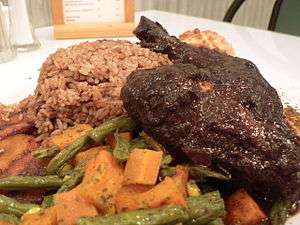Jamaican jerk spice

Jerk is a style of cooking native to Jamaica in which meat is dry-rubbed or wet marinated with a very hot spice mixture called Jamaican jerk spice. Jerk seasoning is traditionally applied to pork and chicken. Modern recipes also apply jerk spice mixes to fish, shrimp, shellfish, beef, sausage, lamb, vegetables, and tofu. Jerk seasoning principally relies upon two items: allspice (called "pimento" in Jamaica) and Scotch bonnet peppers. Other ingredients may include cloves, cinnamon, scallions, nutmeg, thyme, garlic, brown sugar, ginger, and salt.
Etymology
The term jerk is said to come from the word charqui, a Spanish term of Quechua origin for jerked or dried meat, which eventually became the word jerky in English.[1]
Jerk is also derived from the action of jerking, which referred to poking meat with holes so that flavor could more easily be absorbed.[1]
The term jerk spice (also commonly known as Jamaican jerk spice) refers to a spice rub. The word jerk refers to the spice rub, wet marinade, and to the particular cooking technique. Jerk cooking has developed a following in US, Canadian and Western European cosmopolitan urban centers with Caribbean/West Indian communities.[2]
Origins
One theory is that Jamaican jerk sauce is actually African since the origins of jerk pork can be traced back to the pre-slavery days of the Coromantee hunters of West Africa. When the British invaded Jamaica in 1655 the Spanish colonists fled, leaving behind a large number of African slaves. Rather than be re-enslaved by the British, they escaped into Jamaica's mountainous regions where they mixed in with the local Taínos.[2]
Though Jamaican jerk sauce certainly was derived from African ancestry, it is something that was adapted and modified over hundreds of years as various cultures added their influence.[3] From the start, changes had to be made since the Coromantee slaves found themselves in new surroundings on the island of Jamaica and were forced to use what was available to them.[4]
As a result, there was naturally a departure from some of the original spices used in jerk and new ingredients were added or substituted as necessary. One new addition to the recipe was the Scotch bonnet pepper, which is largely responsible for the heat found in Caribbean jerks.[5]
Techniques
The cooking technique of jerking, as well as the results it produces, has evolved over time from using pit fires to old oil barrel halves as the container of choice.[6] Around the 1960s, Caribbean entrepreneurs seeking to recreate the smoked pit flavor in an easier, more portable method came up with a solution to cut oil barrels lengthwise and attach hinges, drilling several ventilation holes for the smoke.[6] These barrels are fired with charcoal, which enhances the spicy, smoky taste. Alternatively, when these cooking methods are unavailable, other methods of meat smoking, including wood burning ovens, can be used to jerk meat. However, oil barrels are arguably one of the most popular cooking methods for making jerk in Jamaica. Most jerk in Jamaica is no longer cooked in the traditional method and is grilled over hardwood charcoal in a steel drum jerk pan.[3]
Street-side jerk stands or jerk centers are frequently found in Jamaica and the nearby Cayman Islands, as well as throughout the Caribbean diaspora and beyond.[7] Jerked meat, usually chicken or pork, can be purchased along with hard dough bread, deep fried cassava bammy (flatbread, usually with fish), Jamaican fried dumplings (known as Johnny or journey cakes), and festival, a variation of sweet flavored fried dumplings made with sugar and served as a side.[8]
Modern day
Jerk cooking and seasoning has followed the Caribbean diaspora all over the world, and forms of jerk can now be found at restaurants almost anywhere a significant population of Caribbean descent exists, such as the United Kingdom, Canada, or the United States.[9] French Caribbean's "Poulet boucané" (Smoked Chicken) is quite similar to traditional Jamaican jerk chicken.[10]
See also
References
- 1 2 The History of Jamaican Jerk http://kitchenproject.com/history/JerkChicken/
- 1 2 "Jerk, Charqui and the Wonders of Walkerswood". Jamaica Observer. 12 February 2015. Archived from the original on 3 August 2015. Retrieved 30 May 2016.
- 1 2 Cloake, Felicity (11 July 2012). "How to cook perfect jerk chicken". The Guardian. Archived from the original on 14 January 2016. Retrieved 31 May 2016.
- ↑ "The Africans". National Library of Jamaica. Archived from the original on 4 January 2013. Retrieved 31 May 2016.
- ↑ Bray, Matt (29 June 2013). "Scotch Bonnet Pepper: The Caribbean Chili of Choice". Pepperscale.com. Archived from the original on 16 March 2016. Retrieved 30 May 2016.
- 1 2 "Jamaican Jerk Chicken". Sunny Tours Jamaica. 20 October 2014. Archived from the original on 20 August 2015. Retrieved 31 May 2016.
- ↑ "Ready to Eat". Skies. Cayman Airways. 1 January 2016. Archived from the original on 3 January 2016. Retrieved 31 May 2016.
- ↑ "Jamaican Festival Recipe". Jamaica No Problem. Archived from the original on 7 September 2015. Retrieved 31 May 2016.
- ↑ Glennie, Alex; Chappell, Laura (16 June 2010). "Jamaica: From Diverse Beginning to Diaspora in the Developed World". MigrationPolicy.org. Migration Policy Institute. Archived from the original on 20 April 2016. Retrieved 31 May 2016.
- ↑ "Cuisine de la Martinique et Guadeloupe". Jamaica Observer. 29 May 2008. Archived from the original on 30 May 2016. Retrieved 31 May 2016.
Further reading
- Cook, Ian and Harrison, Michelle. "Cross over Food: Re-Materializing Postcolonial Geographies". Transactions of the Institute of British Geographers, New Series, Vol. 28, No. 3 (September 2003), pp. 296–317. Blackwell Publishing on behalf of The Royal Geographical Society (with the Institute of British Geographers)
- Connelly, Michael Alan (December 18, 2014). "20 Must-Try Street Foods Around the World". Fodor's. Retrieved July 24, 2016.
External links
![]() Media related to Jamaican jerk spice at Wikimedia Commons
Media related to Jamaican jerk spice at Wikimedia Commons